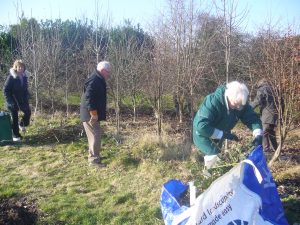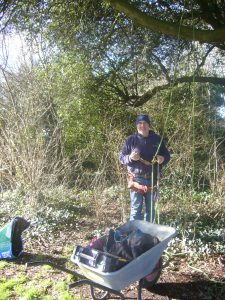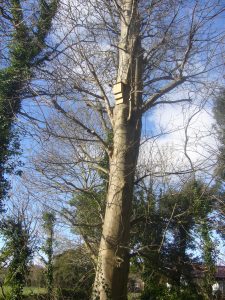If you’ve walked along either of the banks of the Ferring Rife recently, in an area that was previously largely devoid of trees, you’ll have noticed the emergence of some young native trees which are providing a very valuable and varied wildlife corridor in the stretch from the road bridge leading into the Ferring Country Centre down to the area known as the North Lagoon. The area bordering both the North and South Lagoons heading down towards the sea already had a much needed belt of native trees, which were planted by members of the Shoreham and District Ornithological Society back in the 1980s.
The new trees have been planted by members of the Conservation Group over the last 6 or so Winters, with many of them being provided as small “whips” free by the Woodland Trust as part of their national programme to replace the many trees and hedgerows lost over the years for various reasons such as the intensification of agriculture.
We have planted on the land here under the control of the Environment Agency (EA) a whole range of trees, including amongst others – Hawthorn, Blackthorn, Silver Birch, Rowan, Hazel and Oak. We’ve even planted two of the quite rare Black Poplar trees which have added to one already growing nearby. With these and other species, they have provided (and will continue to provide) a rich mix of species and habitats, and we have already seen different animals, insects and birds making use of them as a home, shelter, a roost or even a singing post.
There have been some challenges, and we have undoubtedly had some losses of these small and quite vulnerable trees. The extremes of weather – be it drought, flood, frosts and heat – have all taken their toll, as well as the competing nettles, grasses and other vegetation. Much credit must go here to our members who regularly cut back around the trees during our work parties, which must help. We’ve also had some problems with snails (which like the plastic protective tubes to live in!), as well as some over enthusiastic mowing by the EA, sadly some vandalism and even hungry sheep.
Just last Autumn, we carried out a full survey of those trees that have survived and I’m glad to say that very nearly 500 of various types are still in situ.
In general, the trees have made a massive difference both to the look of the area as well as its value to our local wildlife, and over the coming years and indeed decades, things can only improve with such a diverse range of habitats. One would really hope that future generations will thank us for what we’ve achieved, but the work continues and we hope to see some of you at our future work parties, a number of which will be on the Rife.
by David Bettiss




